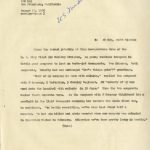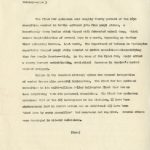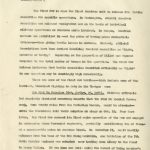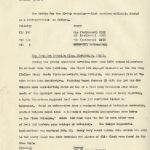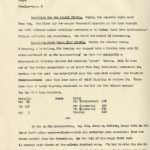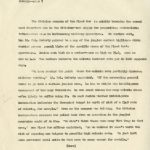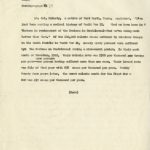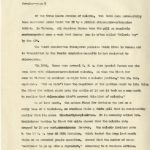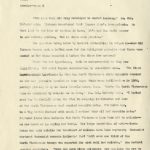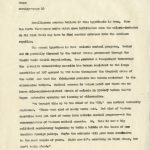1966, August 12, “Two Friends, Both Sergeants”
Beverly Deepe
% JUSPAO
APO 143
San Francisco, California
August 12, 1966
cavalry–page 1 US. Medical
AX AN KHE, SOUTH VIETNAM
Along the tarred jetstrip at this headquarters town of the U. S. Army First Air Cavalry Division, as young American troopers in battle gear prepared to load on turbo-jet transports, two friends, both sergeants, briefly met and exchanged “How’s things goin’?” greetings.
“Half of my company is down with malaria,” replied the sergeant with B Company, 2 Battalion, 5 Cavalry Regiment. 72 “Seventy of my men went into the hospital with malaria in 30 days.” Then the two sergeants rushed their separate ways. As the sergeant with B Company thightened his x seatbelt in the light transport carrying him towards the South China Sea, he continued, “On battle casualties, we’ve also lost about half a company. We had six killed and sixty wounded when our company was ambushed in Operation Masher in February. Otherwise we’ve been pretty lucky in battle.”
(More)
Deepe
Cavalry–page 2
The sergeant’s conversation intimately telescopes the staggering proportions in which Communist troops and malaria-transmitting mosquitoes have combined to hit the elite First Air Cavalry Division, affectionately clle called here the First Cav, which reportedly “leads all other American units in malaria cases.” For the first time in the Vietnam war, an American division has officially released its battle the number of its battle casualties and malaria cases: 2800 by malaria, of which 9 died; 625 killed in action; 1850 wounded in action; six missing in action. An additional 2500 casualties were sustained in non-battle circumstances. The malaria incident rate of all other American units operating in Vietnam is classified.
During the first eleven months of combat in Vietnam, the First Cav’s combined total of 5272 malaria cases and battle casualties have gnawed away nearly sixty percent of the strength of the 8,000 or 9,000 troopers in the eight “maneurver” battalions who regularly stomp the jungles infested with Viet Cong guerrillaak guerrillas, North Vietnamese regular units and malara malaria-carrying female Anopheles mosquitoes. While the total strength of the augmented First Cav reaches 20,000, the 12,000 support troops in helicopter maintenance, logistics, and administration who rarely leave the An Khe base camp for extended tactical operations are also those rarely hit by the plasmodium falciparum strain of malaria. It is only in some of the densest jungle in the world that the Cav’s “leg” troopers must wage a double battle against the male Communist and the female Anopheles.
(More)
Deepe
Cavalry–page 3
The First Cav spokesman said roughly twenty percent of the 1850 casualties wounded in battle suffered jabs from punji stakes, a hasardously sharp bamboo stick tipped with fermented animal dung, which causes hospitalization of several days to a month, depending on whether blood poisoning invades. Last month, the Department of Defense in Washington reportedly dropped punji stake wounded as combat casualties–disqualifying them for Purple Hearts–which, in the case of the First Cav, would effect a twenty percent articifically, statistical decrease in America’s combat wounded category.
Unique in the American military system for command integration of combat troops plus powerful helicopters, the First Cav has suffered casualties to its multi-million dollar heliocpter fleet that are no less surprising than its personnel casualties. The First Cav spokesman announced that of the 465 helicopters in the division, 11 have been shotsmownmzz lost in combat action and an additional 265 have been “shot down by enemy groundfire” but recovered and repaired. Several others were destroyed in mid-ar collisions.
(More)
Deepe
Cavalry–page 4
The First Cav is also the first American unit to release its battle casualties for specific operations. In Washington, overall American casualties are released weekly–but not on the basis of individual military operations or American units involved. In Saigon, American newsmen are prohibited fr –at the price of having press credentials withdrawn–from giving battle losses in numbers. Instead, official descriptions have been devised labelling American casualties as “light, moderate or heavy,” depending on the proportion of killed and wounded compared to the total number of troops in the operation. The First Cav release indicates that battle casualties described officially as “light” in one operation may be shockingly high numerically.
These are some of the First Cav battles–which include some of the heaviest, bloodiest fighting to date in the Vietnam war:
The Plei Me Campaign (Oct.23-Nov.26, 1965). Military officials had regularly dismissed recurring reports that the Plei Me Special Forces camp, twox twenty miles from the Cambodian border, would be attacked–until the Communists laid their surprise se siege on Oct. 19. Four days later, the First Cav enteresd its first major operation of the war and engaged in succession three Communist regiments, partially annhiliating two of them.–at a considerable price in American blood. On November 17, as it hastily withdrew from the base of the Chu Phong mountain, one battalion of the 7th Cavla Cavalry Regiment was ambushed near Landing Zone Albany in the famed Ia Drang Valley. It was thex and still holds the record of being America’s costliest, bloodiest day in the Vietnam war with 151 Americans killed, 121 wounded versus 473 Communist confirmed dead and an additional 100 estimated killed. (More)
Deepe
Cavalry–page 5
The totals for the 33-day campaign–which American officials lauded as a victory–werex as follows.
Friendly Enemy
KIA 300 Kia (bodycount) 1519
WIA 524 KIA (estimate)2042
MIA 3 Individual weapons 895weapons 1011
The Bong Son Campaign (Jan. 25-March 5, 1966).
During the 39-day operation coverng more than 1600 square kilometers in eastern Binh Dinh province, the First Cav enaged elements of the Sao Vang (Yellow Star) North Vietnamese-Vietn Cong Division, and rendered five of the nine battalions ineffective. Fighting began January 29 with the 3rd Air Cav Brigade airx heli-lifting right on top of a Viet Cong battalion four miles north of the district town of Bong Son. During three days of heavy fighting, a North Vietnamese regiment lost more than 500 confirmed killed by bodycount. Based on information from a captured Communist battalion commander, another brigade moved into a Communist regimental headquarters area known as the “Iron Triangle,” which for four days was hit by wave after wave of B-52 SAC bombers plus volleys of artillery. The reigme regimental headquarters was captured Feb. 21. Enemy body count during this action was only 54 but enemy blood ran from trenches and pieces of flis flesh were found in the tree tops.
Friendly Enemy
KIA 228 KIA (bodycount) 1342
WIA 834 KIA (estimate) 1746
MIA 0 WIA (estimate) 1348
Weapons 260
Deepe
Cavalry–page 6
Operation Bee Bee (April 28-29). During two weparate raids near Bong Son, the First Air Cav caught Communist elements in the open terrain and with airborne rocket artilery conducted x “a turkey shoot from helicopters.” Without suffering any casualties, the First Cav killed 71 Communists,.
Operation Crazy Horse (May 16-31). During the evening hours, B Company, 2 Battalion, 8th Cavalry was dropped into a landing zone only 5 miles northeast of An Khe headquarters. on what was originally a company-sized training mission for incoming “green” troops. Only 14 came out of the battle unscratched as at least Viet Cong battalions surrounded it. Another Air Cav unit was heli-lifted near the encircled company and required fouromonemhours more than four hours of stiff fighting to relieve it. Three more days of heavy fighting continued as the 1st Air Cav Brigade enaged the 2nd Viet Cong Regiment.
Friendly Enemy Enemy
KIA 78 KIA (bodycounty) 501
WIA 158 KIA (estimate) 380
MIA 1 WIA (estimate) 175
Weapons 112
***
At the An Khe headquarters, Lt. Col. James E. McCarty, keeps tabs on the First CAv’s other enemy–malaria–which has inflicted more casualties (but far fewer deaths) than the Communists. On the wall of his muggy field tent is covered with charts of the malaria incident rate. “we had to maek the charts expotential,” he quickly advises guests, “orh “or they would be higher than the top of the tent.”
(More)
Deepe
Cavalry–page 7
The division surgeon of the First Cav is quickly becoming the second most important man in the division–not simply for prescribing anti-malaria tablets–but also in influencing military operations. On another wall, hav Lt. Col. McCarty explained. “If the commanding general wants to go into a certain jungled area, he has to weight his intelligence assessment of how many Communists he can smash versus how many malaria cases we’re likely to suffer doing it. He must decide whether intelligence information indicates the Communist target is worth of risk of a 25.0 rate of malaria, for example.” Even as the surgeon was talking, the division headquarters elements had pulled back from an operation in the jungled mountains south of An Khe. “We didn’t think there were many Viet Cong in that area,” one First Cav officer explained, “so we decided it wasn’t worth the risk of exposing one brigade to possible high malaria rate. We just left some scattered small units in that area to snoop around for awhile.”
(More)
Cavalry–page 117A
Lt. Col. McCarty, a native of Fort Worth, Texas, explained, “I’ve just been reading a medical history of World War II. What we have here in V Vietnam is reminescent of the Marines in Guadalcanal–but we’re doing much better than that.” Of the 100,000 malaria cases suffered by American troops in the South Pacific in World War II, nearly sixty percent were suffered byk the Marines on Guadalcanal during a nine-month period. In their peak month of November, 1942, their malaria rate was 1700 per thousand per troops per year–some personsone person having suffered more than one case. Their lowest rate was July of that year with 608 cases per thousand per year. Twnety Twenty four years later, the worst malaria month for the First Car w Cav was 432 cases per thousand per year.
(More)
Deepe
Cavalry–page 8
Of the three known strains of malaria, two have suce successfully been contained since World War II by a pinkish cloroquine-prioquine tablet. In Vietnam, all American forces take the pill so regularly somMondaymthem once a week that Monday asx is often called “Malaria Day” by the GI’s.
The third strain,–the falciparum parasite which lives in humans and is transmitted by the female Anopheles mosquito is now resistant to chloroquine.
“In 1964, there were several U. SL S. S ec Special Forces men who came down with chloroquine-resistant malaria, so when the First Cav came to Vietnam we realized we might have a malaria problem,” the Lt. Col explained. “But we didn’t know the magnitude of the problem would be like this. The First Cav walked right into the middle of it and it took us a mos month to realize that chloroquine didn’t prevent this kind of malaria.”
As of last month, the entire First Cav Division was put on a daily dose of a tasteless, ox ordorless while p white pill that is considerably smaller than its name: diaminodiphenylsulfane. It is commonly call DDS. Preliminary testing by First Cav units showed that the malaria rate dropped by 50 per cent.malariaxaxx However, the malaria incident rate by the Us U. S. Army 26 26th Division, which tested the drug last month while on an extended jungle operation, showed that the number of cases “continued to go up like a skyrocket,” according to T American officer.
(More)
Deepe
Cavalry–page 9
“DDS is a very old drug developed to combat leprosy,” Lt. Col. McCarty said. “Someone remembered that lepers didn’t have malaria. So that lead to the idea of testing it here. It’s not the whole answer to our malaria problem, but it shows real promise.”
The question eing asked by medical authorities in Saigonis–how did Vietnam become such a hotbed area for the falciparum parasite when there were suchxf so few cases reported f before the First Cav arrived?
There are two hypotheses, both as controversial as they are significant, but still beyond confirmation by scientific data. The first hypothesesmmm hyptothesis is that the North Vietnamese units Laosgkmm carried in the new parasite species as they began their mass infiltration in 1964, perhaps picking it up in ther travels across Laos. “Maybe the North Vietnamese were as surprised by malaria as we were,” Lt. Col. McCarty said. “I looked over the battlefield after the Plei Me campaign in November and none of the North Vietnamese dead carried mosquito nets. Two monts ago, in a big battle further soth south I noticed they all had mosquito nets.” Captured items also indicate the North Vietnamese have been hit by malaria–no one knows or is saying how badly. But large quantities of anti-malaria drugs and quni quinine for treatment of malaria have been captured; Communist captured Communist records indicated that “well over one third of the North Vietnamese troops who reported for sick call had malaria,” one medical sources explained. “More and more pirso prisoners are peopleho who are to sick to travel with their units.”
Deepe
Cavalry–page 10
Intelligence sources believe if this hypothesis is true, then the North Vietnamese units which once infiltrated down the malaria-infested Ho Chi Minh Trail may have to find another entrance into the southern republic.
The second hypothesis is that malaria control programs, backed and ft practically financed by the United States government through the Whorld World Health Organization, has produced a two-pronged boomerang: the parasite transmitting mosquito has become resistant to the large quantities of DDT sprayed by WHO teams throughout the tropical areas of the world and that the falciparum parasite has become resistant to the chloroquine tablets. Medical sources in Saigon point out there was no known chloroquine-resistant strain of malaria in 19644-47 before theWHO began extensive spraying and issuing of chloroquine.
“We brought this up to the chief of the WHO,” one medical authority explained. “There were alot of nasty words said. But alot of Western countries have put alot of money into malaria control programs–at the recommendation of Western medical experts. So, this is now a big political controversy beginning to buble a bubble at the basis of omx American foreign policy. Maybe the evidence will grow more conclusive in the next couple of years. Right now it’s something we think about, but don’t talke about.”
-30-
Read Previous Article: 1966, March 17, “Hold Free Elections in Vietnam”
Read Next Article: 1966, August, “Medical Interviews”

